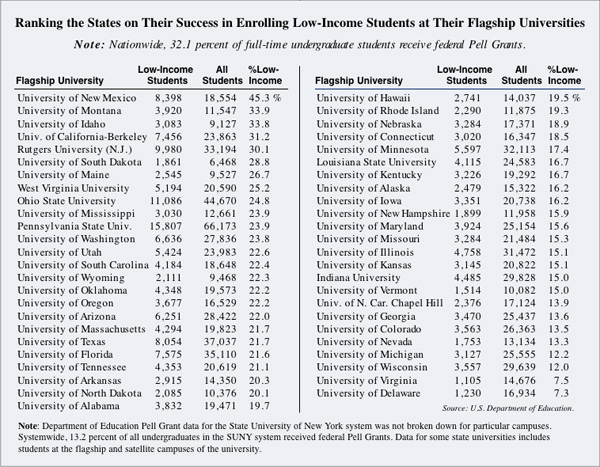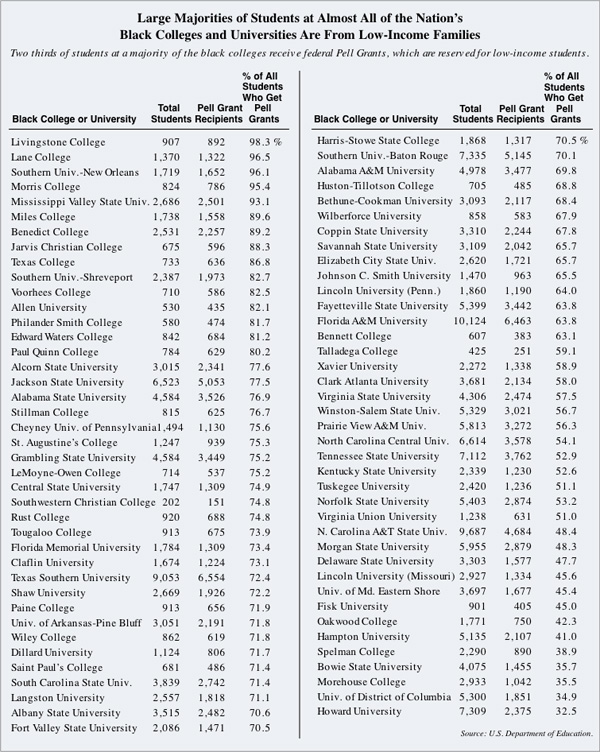| Ranking the Nation’s Flagship State Universities and Historically Black Colleges on Their Success in Enrolling Low-Income Students The nation’s flagship state universities have a mixed record in their efforts to enroll low-income students. But a large majority of black colleges and universities in the United States have student bodies in which more than one half of all students come from low-income families. In recent issues of JBHE* we have reported the disappointing and surprisingly small percentages of low-income students at the nation’s highest-ranking private colleges and universities. For example, over the past two decades only 10 of the nation’s 30 highest-ranking universities have shown an improvement in their percentage of low-income students. Over the past two years, only two of the 30 highest-ranking universities have shown improvement. Now let’s turn to the performance of the so-called flagship state universities as well as to the historically black colleges. We first examine the performance of the nation’s large flagship state universities. Data ob-tained by JBHE from the U.S. Department of Education shows that in the 2006-07 academic year there was a very large disparity in performance among the flagship state universities. Among the large flagship state universities, the best performance was at the University of New Mexico. At the University of New Mexico, 8,398 students received Pell Grants in the 2006-07 academic year. They made up 45.3 percent of the undergraduate student body at the flagship university. In New Mexico there are large numbers of low-income Hispanic and American Indian families, and it appears that many of them are enrolled at the state’s flagship educational institution. Hispanic students make up 35 percent of total enrollments at the university. Six percent of the students are American Indians and 3 percent are black. There are four other flagship state universities where at least 30 percent of all students qualify for federal Pell Grants. They are the University of Montana, the University of Idaho, the University of California at Berkeley, and Rut-gers University in New Jersey. In Montana and Idaho, many students from middle- and upper-income families go out of state to attend more selective and academically prestigious colleges and universities. At Berkeley there are large numbers of students from low-income Asian families. At Rut-gers, 30.1 percent of the undergraduate students come from low-income families. Like Berkeley, Rutgers is one of the most racially diverse flagship state universities. At Rutgers, whites make up only 53 percent of the undergraduate students. The large majority of flagship state universities fall into a range where between 15 and 22 percent of all undergraduate students come from low-income families. There are only eight flagship universities where the Pell Grant percentage falls below 15 percent. Among these eight flagships are the high-ranking University of Virginia, the University of Michigan, and the University of North Caro-lina at Chapel Hill. These three schools all have taken steps to make higher education more affordable to low-income students. However, financial aid assistance for low-income students has not had a major impact on the ability of these low-income students to gain admission to these selective universities. There is a direct correlation between family income and scores on standardized tests for college admission. Therefore, low-income students in Virginia, Michigan, and North Carolina tend to have difficulty competing for places at these highly selective flagship institutions. In states such as Idaho, Montana, New Mexico, and South Dakota, admission to the flagship state university is no-where near as competitive or selective as in Virginia, Michi-gan, or North Carolina. Thus, many low-income students are able to gain admission to the flagship institutions in these mostly rural, less populated states.
The University of Delaware has the lowest percentage of Pell Grant recipients of any of the flagship universities. Only 7.3 percent of all undergraduate students at the university qualify for Pell Grant awards. The University of Delaware attracts a large percentage of its student body from other states. Most students from out of state are not from low-income families because they are obliged to pay higher tuition costs for non-Delawarians. Tuition at the University of Delaware is $8,150 for students from Delaware and $19,400 for out-of-state students. Thus, low-income students from surrounding states are more likely to stay in their own state in order to take advantage of their state’s lower costs rather than travel to Delaware where costs are considerably higher. However, students from middle- and upper-income families in surrounding states are attracted to the University of Delaware because of the institution’s academic reputation and tuition costs that are well below most private colleges and universities in the region. In addition, a large percentage of low-income families in Delaware are black. Students from these families have tended to gravitate toward, or be funneled to, Delaware State University, a historically black institution. Only 6 percent of the students at the University of Delaware are black.
At Black Colleges and Universities, Pell Grant Students Are the Norm At the nation’s historically black colleges and universities an entirely different story emerges concerning the enrollment of students from low-income families. In fact, at a majority of all black colleges, two thirds or more of all enrolled students receive federal Pell Grants. There are five HBCUs at which more than 90 percent of all students receive Pell Grants. At Livingstone College in North Car-olina, 98.3 percent of all undergraduate students qualify for federal Pell Grants, the highest percentage among the black colleges and universities. Lane College, Morris College, Mississippi Valley State University, and the Southern University campus in New Orleans each have a student body where 90 percent or more receive Pell Grant awards. There are another 10 black colleges and universities where more than 80 percent of the students are Pell Grant recipients. These include Benedict College, Allen University, and Voorhees College, all in South Carolina. There are only 13 HBCUs at which low-income students are not a majority of all students. Among these schools are many of the nation’s more selective black colleges and universities. Spelman College and Morehouse College in Atlanta have less than 40 percent of their undergraduate students who qualify for Pell Grant awards. Howard University, the highly regarded historically black university in the nation’s capital, has the lowest percentage of Pell Grant recipients among the HBCUs. At Howard University, only 32.5 percent of all undergraduates received federal Pell Grants in the 2006-07 academic year. The fact that such a large percentage of all students at the nation’s historically black colleges and universities come from low-income families demonstrates the continuing need for increased financial support from the federal government for these institutions. With so many students from impoverished families, there is a tremendous need for student financial aid. Also, the fact that so many students come from low-income families makes it extremely difficult for these schools to raise significant endowment funds because parents and alumni are predominantly from lower socio-economic groups. *See “Despite Surging Endowments, High-Ranking Universities and Col-leges Show Disappointing Results in Enrolling Low-Income Students,” JBHE, Number 57, Autumn 2007, p. 49. |
|





